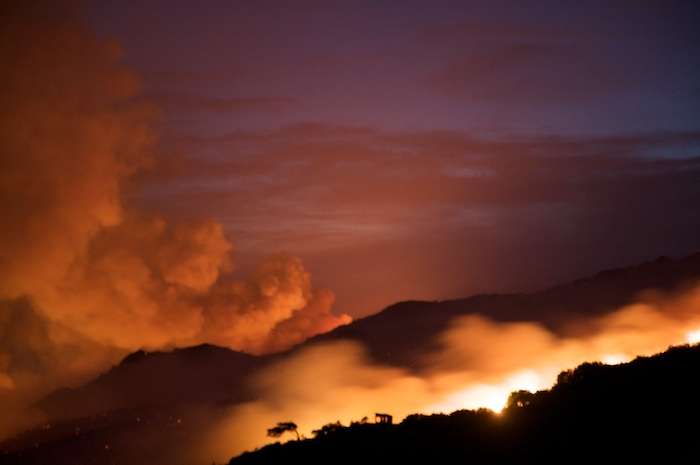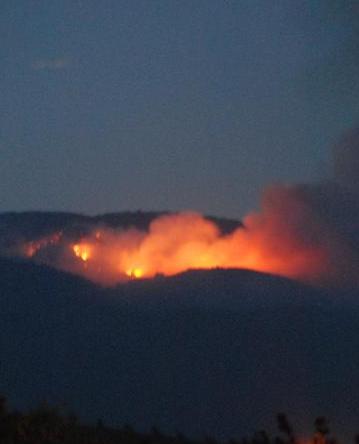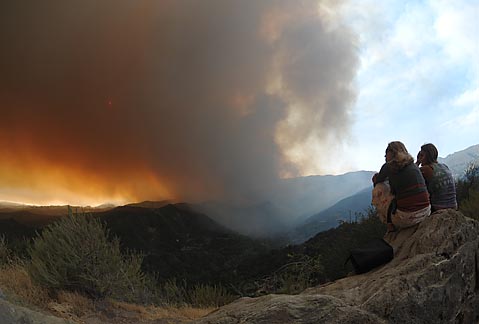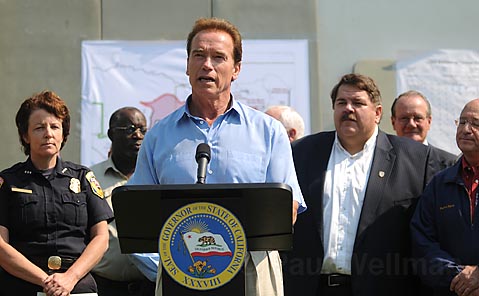The Great Gap Fire of 2008
Wildfire Above Goleta Scorches More than 10,000 Acres, Costs More than $10 Million, and Sends Southern Santa Barbara County Scrambling in Terror

The now infamous Gap Fire was nearly over before it started. By the time firefighters responded to the 911 call at 5:32 p.m. on July 1 that reported a fire near West Camino Cielo Road in the mountains above Goleta, the blaze was but a quarter acre. “The first hour we thought we had it picked up. I honestly thought we had it,” said County Fire spokesman Captain Eli Iskow, who was one of the first on the scene. “But a wind gust came in and just took it over and down into the drainage.”
More than a week later, the Gap Fire has scorched more than 10,000 acres of land, stretching its flaming wings to the south, east, and west, seriously threatening hundreds of houses, and forcing thousands of Goleta and countless mountain community residents out of their homes amid the July 4th holiday weekend. Major roads were closed, holiday parties were cancelled, and power outages became-and continue to be-a daily slice of life for many southern Santa Barbara County residents. No fewer than 2,500 firefighters from 28 states have joined in to fight the blaze, which has already cost more than $10 million and prompted Governor Arnold Schwarzenegger to declare it California’s number-one firefighting priority during an emergency visit last week.
Though as of press time the blaze was more than 50 percent contained-essentially taking most of the populated areas near Fairview Avenue, Cathedral Oaks Road, Glen Annie Road, and Old San Marcos Road out of harm’s way-the human-caused inferno continues to rage west toward the wilderness of Gaviota, its flames currently licking the edges of Eagle Canyon, Naples, and Dos Pueblos Ranch. In its wake is an ash-coated week of terror and smoky-eyed panic the likes of which the South Coast has not seen in years.

The Monster Explodes
Immediately after the wind gave the Gap Fire a new and more dangerous life on the evening of July 1, more than 200 firefighters-including support from helicopters, tankers, and bulldozers-scrambled to protect the communities below. Mandatory evacuation orders were issued for the residents of La Patera and Glen Annie canyons and evacuation warnings were spread to everyone north of Cathedral Oaks Road between Fairview Avenue and Glen Annie Road. But even with clear views of orange flames and billowing smoke visible from as far away as Santa Barbara, fire officials downplayed the severity since weather was on their side.
Similar weather patterns the next day, July 2, kept the fire on the tame side for a while, burning only a few hundred acres as investigators scoured the fire’s origin to determine whether it was arson or an accident. (That investigation is ongoing.) Then, as evening approached, the sundowners kicked up, and flames shot literally 100 feet high. It became evident that the Gap Fire was a much more immediate and terrifying beast than its historic predecessor, the Zaca Fire, was just a year ago.
But with more than 1,400 wildfires burning throughout the Golden State, including the massive and daunting Basin Complex Fire ravaging Big Sur, the Gap Fire still seemed to be an afterthought for all except those directly in its path. All that changed on Thursday, July 3, when the fire grew from 300 to more than 2,000 acres in a matter of hours. Though Santa Barbara City Hall promised the Independence Day fireworks show would go on, Goleta cancelled theirs, evacuation warnings turned mandatory for many neighborhoods, and county officials declared a state of emergency. The fire also started affecting those many miles from it, as power outages brought darkness to more than 150,000 customers from Isla Vista to Montecito and beyond. These were caused by the Gap Fire’s western perimeter, which burned directly under the power lines that come from an Edison substation in Glen Annie Canyon.
At an emergency Board of Supervisors hearing, the county’s Deputy Fire Chief Tom Franklin revealed that the Gap Fire, with its largely uncontained perimeters and close proximity to densely populated urban areas, had now become “priority number one” in the eyes of the Sacramento, a dreaded distinction but one that also meant major reinforcements were on the way. With thumbnail-sized ash raining down as far away as the Santa Barbara’s Eastside and much of Goleta choked by an eerie dark smoke, panic was gripping much of the South Coast, especially those who remembered 1990’s horrific Painted Cave Fire. But fire officials remained calm. “Everywhere the fire threatens a structure,” Franklin told the county supervisors, “we already have equipment in place.”

By nightfall, mandatory evacuations were in place for residents of the West Camino Cielo, Kinevan Ranch, Haney Tract, Hidden Valley, and San Marcos Trout Club communities as well as all homes north of Cathedral Oaks Road in between Fairview and Patterson avenues. More than 5,000 people would be homeless for the holiday, some of them seeking refuge at the Red Cross-run shelter at San Marcos High School, others at nearby hotels such as the Bacara (which had high occupancies due to lower, disaster-related rates), and most moving in with friends or family.
On the Fourth of July, firefighter forces swelled from 350 to 800 in fewer than 24 hours and the aircraft amount bumped from six to 20, including a DC-10 that made five effective drops. But the fire raged back, jumping to more than 5,500 acres by lunchtime. As Independence Day festivities began, stories filtered in about an amazing firefight the night before: Several hundred houses along North Fairview Avenue and Camino Manadero off North Patterson Avenue were rescued from certain destruction by the unflinching work of fire crews who refused to give up their ground despite the advancing flames and hunks of still-burning embers falling from the sky. The firefighters, in some cases, had to catch breaths of fresh air and regroup inside the very homes they were saving. As Captain Iskow explained, “It’s not that we didn’t lose those houses-it’s that we saved them.”
As the traditional hour of fireworks approached, serious devastation became a distinct possibility as the Gap Fire burned actively on three fronts: north toward Camino Cielo, east toward Highway 154, and west into Goleta. “The real scary part,” summed up one Goleta Public Works employee that afternoon, “is that nothing seems to be getting any better.” Evacuations were mandated for all residents north of Cathedral Oaks Road between Farren Road on the west and Highway 154 on the east. By 10 p.m. on the 4th, 50 mph sundowners blew the fire treacherously close to Painted Cave and Trout Club houses; so close, in fact, that County Fire Chief John Scherrei would later admit that, on two occasions, he was convinced at least 100 homes would be lost. Miraculously, dawn on July 5 revealed that all structures, save for a few storage sheds, were still intact.

Threat Subsides, Lessons Are Learned
During a press conference at Earl Warren Showgrounds on Saturday, July 5, Governor Arnold Schwarzenegger, whose otherworldly orange hair matched the eerie golden sunshine outside, confirmed that the state’s top priority was still the Gap Fire, which had burned 8,300 acres by then. The Governator promised that 2,500 firefighters and even more aircraft would be fighting the fire by nightfall. Referring to the rash of wildfires throughout California, Schwarzenegger then offered an ominous observation, followed by a proposed solution sure to affect budget dealings in the months to come. “Now there is no more fire season,” he said. “We have fires all year round. What this means is we need more resources.” So he’s allocated $70 million in emergency response funding that would be paid for by charging homeowners an additional dollar per month per property. “There will be some who will start debating is this a fee or is this a tax increase,” he predicted. “I don’t care what they call it. We just want additional revenues.”
As national news teams sent images of supposed terror in the 805 throughout the world on Saturday, the firefighters were actually enjoying their most successful day to date thanks to favorable weather and weak sundowners. Some evacuation orders were lifted, the fire line along West Camino Cielo (Road) was holding, and crews working the eastern and southern flanks of the fire-those closest to major neighborhoods-were extremely successful in “buttoning things up.”
By sun-up on Sunday, Montana-based Incident Commander Wally Bennett told a throng of reporters, “The news so far is good-real good.” He credited the success to work done early on by Santa Barbara County crews and said the battle had shifted to the eastern Gaviota Coast near Eagle Canyon, Naples, and the Dos Pueblos Ranch, and to the north along West Camino Cielo Road, where a critical boundary must be maintained to stop the fire from jumping into the Santa Ynez Valley. “This fire wants to move west and it is in some very rugged and unsafe territory for firefighters,” explained Bennett in a statement on Sunday, which still rings true as of Wednesday’s press deadline. “To safely [fight] it, everything is going to have to be in our favor.”
Luckily, that’s been exactly what’s happened since Sunday. Coastal fog and a moist onshore flow has made high afternoon temperatures bearable, allowing containment lines to be built as deep as Refugio Road, firebreaks near Old San Marcos Pass Road to be strengthened, and the area around West Camino Cielo Road to be cleared further. Though the fire has increased to more than 10,000 acres, its growth has slowed drastically, no homes have been lost, and most evacuation orders have been lifted, save for the Gaviota ranchlands and mountain communities near West Camino Cielo. Meanwhile, the Federal Emergency Management Agency has allocated federal funds to reimburse up to 75 percent of the firefighting fees.
In addition to favorable weather and the hard work of firefighters, some are saying that the biggest weapon against this inferno was agricultural land. Avocado and lemon orchards and cattle ranching all played drastic roles in stopping the fire’s spread to urban areas. “The fire was actually almost completely stopped when it hit some of these orchards,” said Captain Iskow. “It would be a great plan to put orchards all through fire country.”
With their irrigation grids, maintained roads, wet soils, and chaparral-free landscapes, Iskow said that agricultural land will either stop a wildfire or, at the very least, slow it down to a crawl. For example, at La Patera Ranch, one of the first areas threatened by the fire, only two acres were lost because longtime cattle grazing reduced the brush. But next door at Bishop Ranch, where there is no agriculture, witnesses said much of the property’s back end was ablaze. (Calls to ranch management have not been returned.) Over at Calavo Growers’ avocado and lemon orchards near the Winchester Canyon and Tecolote Canyon neighborhoods, nearly 200 acres had burned earlier this week. But manager Ken Stanley remained proud, explaining, “[The orchards] worked as a buffer and protected Goleta.”
Agricultural buffers or not, the Gap Fire is still ablaze, and no wildfire is dead until it’s 100 percent out. “Certainly there is a good deal to be optimistic about, but we don’t want to pull any punches,” said Deputy Chief Tom Franklin over the weekend before reminding everyone of how the months-long Zaca Fire was nearly extinguished numerous times before its September 2007 finale. “It’s is not over until it’s over.”



